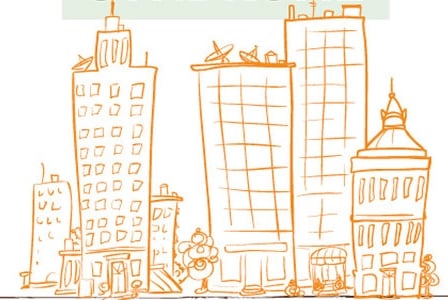
Is your workplace or school making you sick? No, we’re not talking about the deadlines, projects or people—we’re talking about the building itself. If being at work or school gives you headaches, nose or throat irritation, fatigue or difficulty concentrating, it may be sick building syndrome (SBS).
What is it?
In basic terms, SBS (sometimes called tight building syndrome) is a condition created by low ventilation, combined with contaminants in buildings such as workplaces or schools. The combination of these factors causes a wide variety of symptoms for many people who use the building. This leaves sufferers feeling sick whenever they spend time there, reducing productivity and increasing absenteeism.
There are many possible contaminant sources responsible for causing SBS symptoms. It can be tricky to figure out exactly which one is the culprit—and sometimes more than one is to blame. Examples include
- chemicals (either from inside or outside sources), such as exhaust; asbestos; radon; volatile organic compounds (VOCs) from furniture and carpeting, copy machines and cleaning products; synthetic fragrances and tobacco smoke
- biological contaminants, such as fungus, mould, bacteria, pollen and insect and bird droppings
Other factors might also be at play, such as inappropriate lighting (either too much or too little), lack of sunlight, poor acoustics and even poor ergonomics.
Perhaps surprisingly, those who work indoors are not immune to outside contaminants, which can enter buildings through vents and windows that aren’t properly located.
How SBS manifests
SBS cannot be accounted for by any other illness and typically affects multiple occupants of the building. However, symptoms are nonspecific, meaning that the syndrome can manifest in different ways in different people. Of course, the common denominator is that the symptoms are directly related to time spent in the particular building. And generally, symptoms disappear soon after leaving the building.
Symptoms
Some of the symptoms commonly experienced in SBS include
- nose, chest or throat irritation (including nosebleeds, coughs, shortness of breath and even chest pain)
- heart palpitations
- occupational asthma
- lethargy
- headache
- dizziness
- nausea
- dry skin
In severe cases, serious conditions such as pregnancy problems, certain cancers or legionnaires’ disease can develop. Always consult a health care practitioner right away if you suspect SBS.
Who is affected?
Some people are more at risk of SBS than others. While research is lacking about children’s likelihood of developing SBS, some things are known about adults’ risk. Sadly, for workplaces, it seems there’s a link between one’s position and one’s risk of developing SBS, as those in higher-up positions (managers and professionals) are more likely to have better working conditions.
It has also been noted in past studies that women are more likely to have SBS. Although researchers aren’t certain of why this is, it may be because women are more likely to work in administrative (rather than managerial) positions, are more affected by contaminants or are more aware of their health and therefore are more likely to report symptoms.
The history of sick buildings
In the 1970s, designers began to make buildings more airtight. While this may be more energy efficient, less ventilation mixed with indoor chemical contaminants began to harm office workers’ health. Not surprisingly, the term “sick building syndrome” also began to pop up in medical research in the 1970s and 1980s.
In 1987, for instance, one of the first studies about SBS investigated 4373 office workers and found that those with inadequate ventilation experienced lethargy, headache and an irritated nose or throat. Another study, this one from 1984, found “a repeated pattern of nasal, eye and mucous membrane symptoms with lethargy, dry skin and headaches” and hypothesised that the problem was much greater than previously thought.
Sick buildings today
Many improvements have been made in building safety since the 1970s and ’80s, and there has also been much more awareness. However, SBS persists. Furthermore, while early research focused mainly on workplaces, new studies have raised questions about similar issues in other buildings—namely, houses and schools.
Sick house syndrome?
Many of the same chemical and biological contaminants found in workplaces are also found in homes, and new research is investigating the consequences of this. One recent Swedish study, for instance, investigated both SBS and sick house syndrome (SHS) in 1000 study participants and found that SBS and SHS are intertwined. Moreover, not only does poor air quality lead to symptoms, but stress and a poor psychosocial environment can also exacerbate problems.
Meanwhile, a US study noted that many houses have excess dampness, leading to fungi and mould growth, which can lead to health symptoms. The researchers also mentioned that VOCs can further contribute to the problem.
SBS in schools?
Sick building syndrome symptoms have been reported in educational institutions. For example, a 2013 study found that improving air quality by reducing elevated levels of carbon dioxide in university computer classrooms might reduce headaches and boost energy.
A recent Japanese study investigated the effects of dampness on 1,077 school children in eight different schools. The children’s homes were also investigated for dampness. The researchers found that dampness in the school classrooms and homes affected the children’s health, leading to symptoms such as a chronic cough, nasal symptoms, dry skin and sleep problems. Interestingly, the children with better diets (fewer snacks and sweets, and who always ate breakfast) had reduced SBS symptoms.
What’s next?
It’s very likely that the body of research about SBS will continue to grow as more places—and more factors—are investigated. For instance, according to a Swedish study, daycare centres and nursing homes are two areas that may be SBS hotspots.
Take action
While SBS may be worrisome, the bright side is that a multitude of things can be done to improve symptoms and even fix the problem.
What you can do
Apart from raising the issue with management of the building and asking for an investigation, employees, parents and students can do many things.
- Create a health committee that helps advocate for building occupants and ensure improvements are made.
- Place indoor plants at your desk or ask for them in classrooms. Houseplants can help purify the air and have been shown in recent studies to improve air quality in schools by reducing VOCs and carbon dioxide concentrations, improving concentration and preventing fatigue in offices, and improving student performance. Helpful varieties include peace lily, Dracaena varieties, Chinese evergreen and snake plants.
- Go for regular walks outdoors on breaks—and encourage others in the building to do the same.
- Use natural cleaning products on your desk space. You may be surprised by what harmful chemicals can be found in everyday cleaning products. Check out the Environmental Working Group’s Guide to Healthy Cleaning (ewg.org/guides/cleaners) to find the best brands and stock up at your local natural health retailer.
- Eat a healthy diet and don’t skip breakfast. This has been shown to help in at least one study of children’s SBS symptoms.
What management can do
Employers and school board officials can do a lot to ensure a safe working or learning environment—and they have a lot to gain by doing so. The Cooperative Research Centre for Contamination Assessment and Remediation of the Environment estimates sick building syndrome costs the Australian economy $12 billion a year in lost productivity and healthcare costs.
If SBS is suspected, or building occupants have complained of symptoms, management can look into hiring a building or mould inspector. Inspection might include a walk-through, air sampling and collecting information from occupants of the building. Ventilation and air distribution may need to be increased, and repairs, maintenance or renovations may need to be undertaken.
Employers and management can also
- ensure routine maintenance of HVAC systems and renovations when needed
- look for low-VOC, natural options when replacing upholstery, painting or using building materials
- make sure that natural, nontoxic cleaning products are used for regular cleaning
- create a no-smoking zone in outdoor areas near vents leading to the inside of the building
- ban perfume and cologne among building occupants
- enact all of the same actions previously mentioned in the “What you can do” section
Environmental sensitivities or sick building syndrome?
There is some confusion between SBS and environmental sensitivities. While SBS is often referred to as a type of environmental sensitivity, it has its own set of characteristics. Unlike environmental sensitivities, SBS typically affects multiple people in the same building and generally disappears very soon after people leave the building.
How healthy is your building?
Is your workplace or school sick? Here’s a short quiz!
- Do you find your building’s temperature comfortable (neither too hot and stuffy nor too cold and drafty)?
- Do you find your building’s lighting is a comfortable level (neither too dark nor too bright)?
- Do you have control over your surroundings—such as chair and computer monitor adjustability or lighting/ventilation/heating levels?
- Do you have access to drinking water?
- Do you have access to fresh air and a separate break area?
- Do you find the building to be adequately and regularly cleaned?
An answer of “no” to any of the questions above may mean that you’re at risk of SBS.
Resources
For more information or advice on SBS, you can contact the health and safety regulator in your state or territory. See safeworkaustralia.gov.au for a full list.



